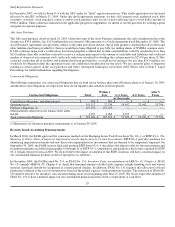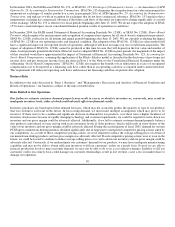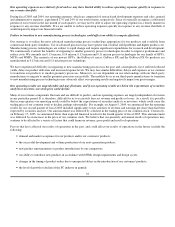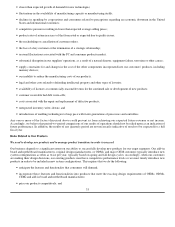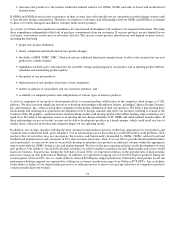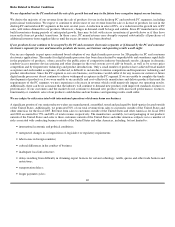NVIDIA 2005 Annual Report Download - page 44
Download and view the complete annual report
Please find page 44 of the 2005 NVIDIA annual report below. You can navigate through the pages in the report by either clicking on the pages listed below, or by using the keyword search tool below to find specific information within the annual report.
• impairment of relationships with employees and customers, or the loss of key employees as a result of any integration of new
businesses and management personnel.
In addition, the consideration for any future acquisition could be paid in cash, shares of our common stock, the issuance of convertible
debt securities or a combination of cash, convertible debt and common stock. If we pay a portion of the purchase price in cash, our
cash reserves would be reduced. If the consideration is paid with shares of our common stock, or convertible debentures, the holdings
of existing stockholders would be further diluted. We cannot forecast the number, timing or size of future acquisitions, or the effect
that any such acquisitions might have on our operations or financial results.
The impact on our future revenue by Microsoft's announcement that it has entered into an agreement with one of our competitors
to develop technology for future Xbox products and services is uncertain.
During fiscal 2004, Microsoft announced that it had entered into an agreement with one of our competitors to develop technology for
future Xbox products and services. The impact that this announcement may have on our future revenue from Microsoft is uncertain,
but we anticipate that we will not achieve historical levels of Xbox revenue in fiscal 2006. Revenue from Microsoft during fiscal
2005, fiscal 2004 and fiscal 2003 accounted for 13%, 15% and 23% respectively, of our total revenue. If our revenue from Microsoft
declines during fiscal 2006, we will need to increase revenue from other customers in order to be able to maintain our current revenue
level and operating results. If we do not replace any reduction in revenue from Microsoft with revenue from other customers, our
operating results would be adversely affected.
Provisions in our certificate of incorporation, our bylaws and our agreement with Microsoft could delay or prevent a change in
control.
Our certificate of incorporation and bylaws contain provisions that could make it more difficult for a third party to acquire a majority
of our outstanding voting stock. These provisions include the following:
• the ability of the board of directors to create and issue preferred stock without prior stockholder approval;
• the prohibition of stockholder action by written consent;
• a classified board of directors; and
• advance notice requirements for director nominations and stockholder proposals.
On March 5, 2000, we entered into an agreement with Microsoft in which we agreed to develop and sell graphics chips and to license
certain technology to Microsoft and its licensees for use in the Xbox. In the event that an individual or corporation makes an offer to
purchase shares equal to or greater than 30% of the outstanding shares of our common stock, Microsoft has first and last rights of
refusal to purchase the stock. The Microsoft provision and the other factors listed above could also delay or prevent a change in
control of NVIDIA.
Risks Related to Our Competition
The 3D graphics, platform processor and handheld industries are highly competitive and we may be unable to compete.
The market for GPUs, MCPs and WMPs for PCs and handhelds is intensely competitive and is characterized by rapid technological
change, evolving industry standards and declining average selling prices. We believe that the principal competitive factors in this
market are performance, breadth of product offerings, access to customers and distribution channels, backward−forward software
support, conformity to industry standard Application Programming Interfaces, or APIs, manufacturing capabilities, price of digital
media processors and total system costs of add−in boards and motherboards. We believe that our ability to remain competitive will
depend on how well we are able to anticipate the features and functions that customers will demand and whether we are able to deliver
consistent volumes of our products at acceptable levels of quality. We expect competition to increase both from existing competitors
and new market entrants with products that may be less costly than ours, or may provide better performance or additional features not
provided by our products, which could harm our business. Further, we expect substantial competition from Intel's publicized focus on
moving to selling platform solutions dominated by Intel products, such as the Centrino platform.
38



